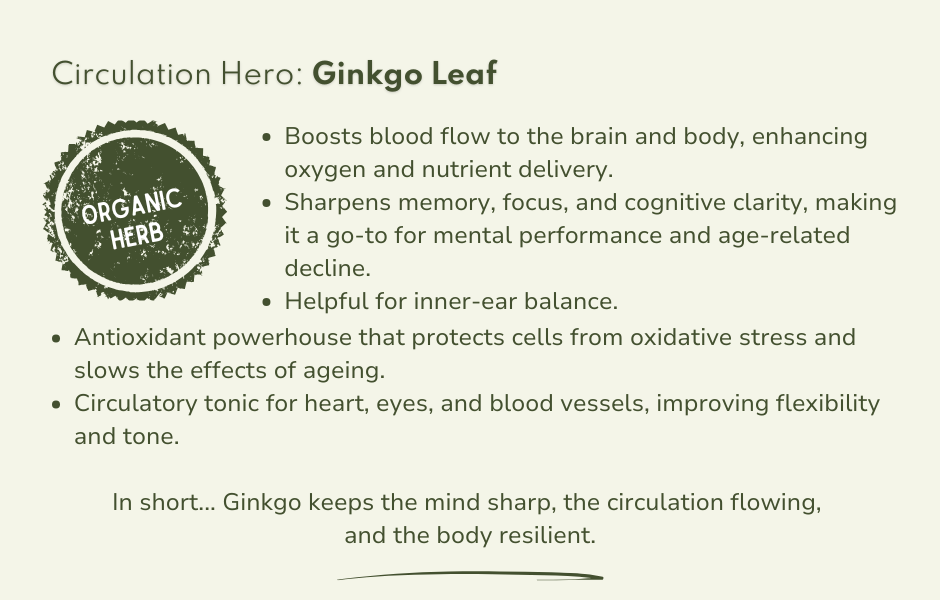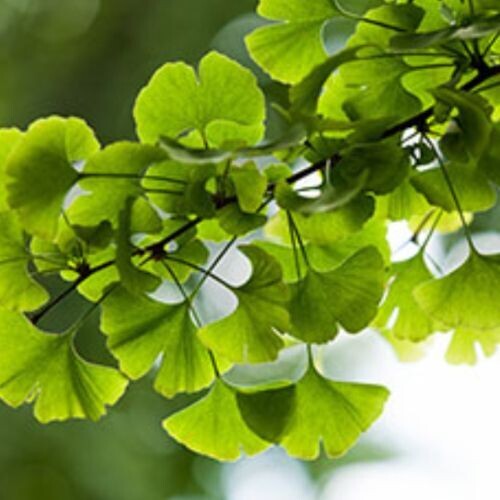GINKGO BILOBA (Maidenhair) *Organic herb for horses
Benefits of Ginkgo Leaf for Horses
Ginkgo is brain food and blood flow support in one - sharpening memory, boosting circulation, and protecting cells with its ancient resilience.
Please note this is a nutritional, functional horse food supplement and not veterinary medicine. For more on this, see Dr Kellon's Horse Sense - Nutrition is not 'Alternative' Therapy
.

Where to find Ginkgo in the EquiNatural range
Here’s where you’ll also find Ginkgo in our supplement support for horses:
- BreathePlus - powerful support for chronic equine respiratory / allergy resilience
- PollenTonic - natural support for spring pollen allergy challenges
- CushTonic - endocrine support for Cushing's/PPID symptoms
- EyeTonic - from everyday eye irritations to long-term support, well indicated for ERU
- OptimaCARE - a comprehensive 3-stage full-body detox reset for equine vitality
- StressTonic - helps 'normalise' the stress response
💧Organic Gingko Leaf Tincture
Our human-grade tinctures give you a ready-to-absorb potent source of phytonutrients at the highest-strength available, for immediate absorption straight into the bloodstream and to the body’s cells.
- Ginkgo biloba
- Leaf, Fresh
- Infused 1:3 25%
- Organic Cultivated
~ Feed Guide - ginkgo tincture for horses
- 6ml/100kg bodyweight, daily in feed.
- Our tinctures come in a heat-sealed, twin-neck, child-resistant HDPE plastic dosing bottle, complete with dosing chamber. *HDPE (High-Density Polyethylene) plastic is 100% recyclable, and energy-efficient to produce. Safe for food/water storage, it reduces waste and emissions while resisting wear. A top sustainable choice to match the EquiNatural ethos.
🌿Organic Dried Ginkgo Leaf for horses
Grown, harvested and dried without the use of agri-chemicals, non-irradiated and GMO free - see our Quality page for Quality Management & Certification Documents.
- Ginkgo biloba
- Leaf
- Organic Cultivated
- Origin China
~ Feed Guide - dried ginkgo leaf for horses
- 5g/100kg bodyweight per day, thus for an average 500kg horse add 25g daily to feed.
- Want a scoop? You can add a scoop to your basket during checkout.
- ♻️Supplied in a 100% fully recylable, resealable, food-grade foil pouch for freshness.
Footnotes
- Laboratory tested for identification and compliance to the British and European Pharmacopoeia standards.
- Human grade.
- Please be aware that if you're purchasing our dried botanicals for human use, our dried range is cut to appropriate sizes for feeding to horses.
- ♻️ Eco Note: Our packaging is recyclable and refillable.
- 🧊 Storage Tip: Keep cool and dry.
Functional Nutritional Value
Constituents: Flavone glycosides, proanthocyanidins, and terpene lactones, quercetin, kaempferol, and isorhamnetin (including coumaric acid esters of flavonoids).
Safety
- Pregnant or nursing mares - always seek veterinary advice before feeding.
- Because ginkgo acts as an anticoagulant, there has been concern expressed in the literature about its potential interaction with blood-thinning pharmaceutical drugs.
Ginkgo Trivia, History, & Tradition
- Fossils show ginkgo leaves dating back 250 million years - dinosaurs may well have snacked on them.
- In Hiroshima, six ancient ginkgo trees famously survived the atomic blast and are still thriving today.
- First brought to Europe in the 17th century, it was nicknamed the ' living fossil'.
- Its fan-shaped leaves are a popular motif in art and jewellery.
History & Tradition
The ancient ginkgo tree is not only a living link to prehistory - it’s one of nature’s most remarkable survivors. Fossils of ginkgo have been dated back over 250 million years, making it quite possibly dinosaur food! It’s so unique that it has no close relatives in the plant kingdom, and its resilience is legendary - able to withstand environmental extremes from lightning strikes to nuclear radiation. In fact, after the atomic bombings of Hiroshima and Nagasaki, ginkgo trees were among the first living things to regrow in the devastated areas.
Native to south-eastern China, ginkgo was traditionally planted around temples in China and Japan. The German botanist Engelbert Kaempfer encountered it in a Nagasaki monastery in 1691, introducing it to the West in 1712. By the late 18th century, it had even reached the American colonies.
A master of circulation and protection
Ginkgo leaf is a potent antioxidant and circulatory enhancer. It’s known for:
- Improving blood vessel tone and increasing capillary circulation
- Acting as an anticoagulant and antithrombotic - supporting healthy blood flow
- Supporting vascular flexibility and reducing platelet aggregation, making it a valuable ally in preventing atherosclerosis and thrombosis
These actions make ginkgo especially useful in conditions linked to poor circulation, such as:
- Tinnitus, vertigo, and inner ear issues caused by reduced blood flow
- Macular degeneration and glaucoma(by improving ocular circulation)
- Cognitive decline and dementia - including enhanced memory and mental clarity in age-related conditions, though evidence for Alzheimer’s prevention remains limited
Brain, mood, and metabolic benefits
Ginkgo can sharpen focus and support neurotransmitter balance, which may help in treatment-resistant depression in older adults. It’s also been studied for type 2 diabetes, where improved blood flow and glucose utilisation may support better metabolic health.
Traditional Chinese medicine
In Chinese herbalism, ginkgo is said to influence the lung and kidney channels, helping to:
- Reduce cerebral and retinal swelling
- Improve bronchodilation and respiratory function
- Support chronic conditions like COPD (often paired with liquorice)
Ginkgo is, in short, a tree of extraordinary longevity with medicinal qualities to match - nourishing circulation, protecting cells from damage, and supporting clear thinking well into old age.


